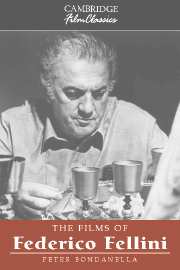Book contents
- Frontmatter
- Contents
- List of Illustrations
- Introduction
- 1 Federico Fellini: A Life in the Cinema
- 2 La strada: The Cinema of Poetry and the Road beyond Neorealism
- 3 La dolce vita: The Art Film Spectacular
- 4 8½: The Celebration of Artistic Creativity
- 5 Amarcord: Nostalgia and Politics
- 6 Intervista: A Summation of a Cinematic Career
- Notes
- Selected Bibliography on Federico Fellini
- A Fellini Filmography: Principal Credits
- List of Additional Films Cited
- Index
4 - 8½: The Celebration of Artistic Creativity
Published online by Cambridge University Press: 12 January 2010
- Frontmatter
- Contents
- List of Illustrations
- Introduction
- 1 Federico Fellini: A Life in the Cinema
- 2 La strada: The Cinema of Poetry and the Road beyond Neorealism
- 3 La dolce vita: The Art Film Spectacular
- 4 8½: The Celebration of Artistic Creativity
- 5 Amarcord: Nostalgia and Politics
- 6 Intervista: A Summation of a Cinematic Career
- Notes
- Selected Bibliography on Federico Fellini
- A Fellini Filmography: Principal Credits
- List of Additional Films Cited
- Index
Summary
For many audiences, critics, and film historians, 8½ remains the benchmark film by Fellini, the work that justifies his status as a master and continues to reward the spectator after numerous screenings. Besides a host of awards (including an Oscar for Best Foreign Film) received when it first appeared in 1963, a group of thirty European intellectuals and filmmakers in 1987 voted 8½ the most important European film ever made and, on the basis of this work, also named Fellini as the European cinema's most important director. The film occupies an important role in the director's complete works, not only because of its obvious autobiographical links to Fellini's life but also because it focuses upon the very nature of artistic creation in the cinema.
La dolce vita is the last film Fellini made with obvious mimetic intention: It provides a panoramic view of a society gone wild with press conferences, image makers, paparazzi, and celebrities, and in spite of its ability to create stirring images of an unforgettable character (such as the Trevi Fountain scene, which was indelibly etched into the imagination of an entire generation of moviegoers), its subject matter remains steadfastly connected to the society within which Fellini lived. After La dolce vita, however, Fellini turns toward the expression of a personal fantasy world that often, as in the case of 8½, also deals with the representation of cinema itself in a self-reflexive fashion. This turn toward a world more directly taken from his own fantasy owes a great debt to his encounter with Jungian psychoanalysis, which Fellini described as “like the sight of unknown landscapes, like the discovery of a new way of looking at life.”
- Type
- Chapter
- Information
- The Films of Federico Fellini , pp. 93 - 116Publisher: Cambridge University PressPrint publication year: 2002



